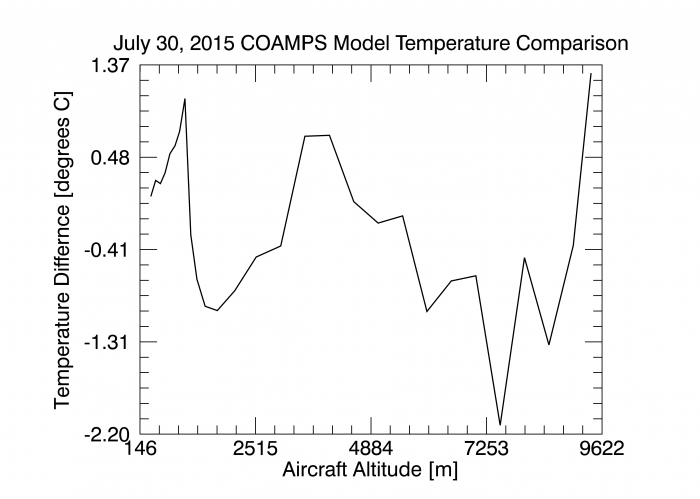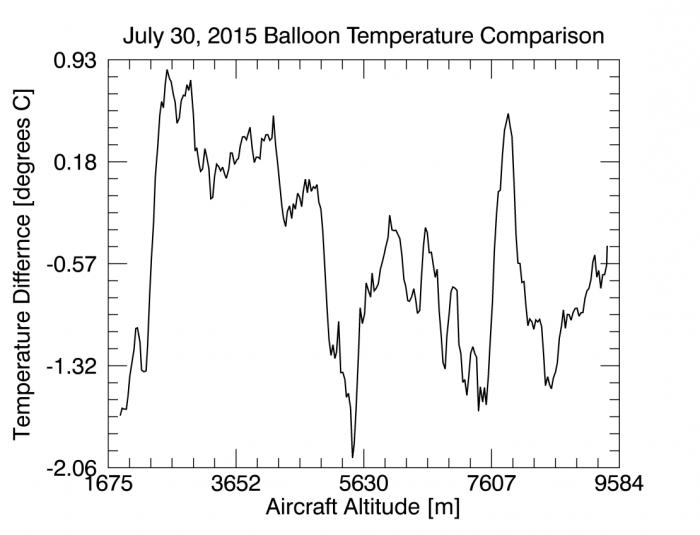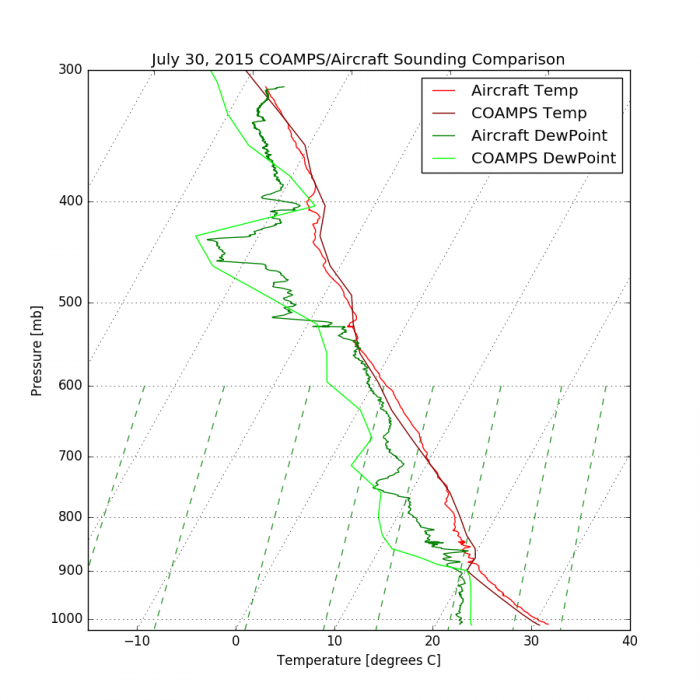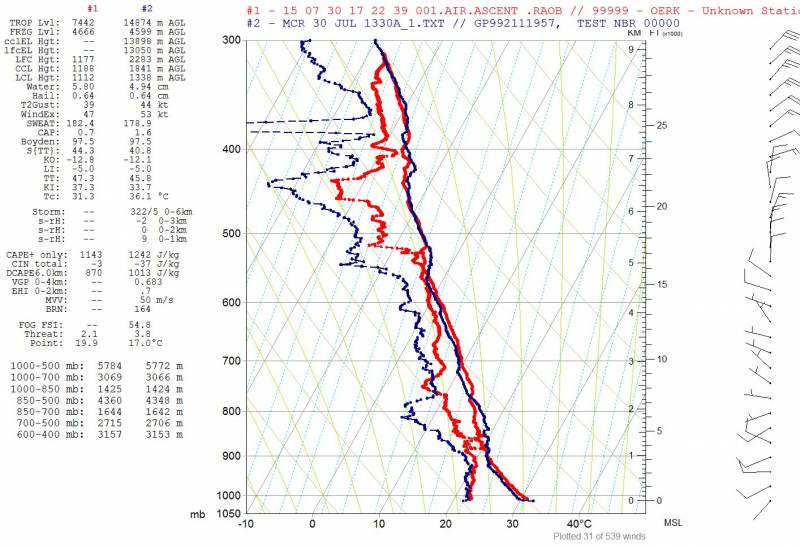Table of Contents
CAPE2015 Aircraft Temperature Comparisons
Objectives
With the CAPE 2015 project, we wanted to compare the temperatures that the Citation II research aircraft recorded to temperatures recorded by radiosonde balloons launched from the site of the Mid-Course Doppler Radar (MCR) at Cape Canaveral, Florida and COAMPS model soundings for the MCR site. Our hypothesis was that the aircraft, balloon, and model soundings would agree more at higher altitudes.
Processing
Scripts
comparesounding
Two python scripts were used to calculate the temperature differences: comparesoundingMCR.py and comparesoundingCOAMPS.py. Both of these scripts are located in $ADPAA_DIR/src/scripts_python .
comparesoundingMCR
comparesoundingMCR.py compares the aircraft temperatures to the MCR radiosonde balloon temperatures. The differences are calculated by finding where the aircraft altitude is closest to the balloon altitude and subtracting the balloon temps from the aircraft temps. The temperature differences, along with some other aircraft and balloon data, are written to a NASA-formatted ASCII file.
To use the script, use the following syntax:
$ADPAA_DIR/src/scripts_python/comparesoundingMCR.py <aircraft file> <MCR balloon file>
This script generates an output file called MCR_<date of aircraft flight>_comp.txt.
comparesoundingCOAMPS
comparesoundingCOAMPS.py compares the aircraft temperatures to the COAMPS model sounding temperatures. The differences are calculated by finding where the aircraft altitude is closest to the model sounding altitude and subtracting the model temps from the aircraft temps. The temperature differences, along with some other aircraft and COAMPS model data, are written to a NASA-formatted ASCII file.
To use the script, use the following syntax:
$ADPAA_DIR/src/scripts_python/comparesoundingCOAMPS.py <aircraft file> <COAMPS model sounding file>
This script generates an output file called COAMPS_<date of aircraft flight>_comp.txt.
cplot2
cplot2 was used to plot the output files generated from the two comparesounding scripts. The temperature differences were plotted on the y-axis and the aircraft altitudes were plotted on the x-axis.
This is the plot of the sounding comparisons for July 30 between the aircraft and the COAMPS model sounding.
This is the plot of the sounding comparisons for July 30 between the aircraft and the radiosonde balloon sounding.
Files
Three types of data were used for this project: aircraft data files from UND's Citation II research aircraft, radiosonde balloon soundings launched from the site of the Navy's Mid-Course Doppler Radar, and COAMPS model soundings for the MCR site.
Aircraft Files
The aircraft data files are located in the PostProcessing folder in the nas drive. These files contained the entire flight, but only the ascent was needed. To get the ascent, the whole flight file was plotted in cplot2. A subset of the file was generated that only contained the ascent. These ascent files are located in /nas/und/Florida/Analysis/AircraftFiles.
MCR Balloon Files
The MCR balloon files are located in /nas/und/Florida/Surface/soundings. This directory contains other folders for each day of the project. In each of these folders, there are a few more folders for the different soundings taken that day. The dates on these folders are in local time, not UTC. Within the folder that corresponds to the aircraft flight, the sounding file ending in “_1.txt” was used. This sounding contains the most data points and works well for comparisons. Copies of the balloon sounding files that match up with the aircraft files are located in /nas/und/Florida/Analysis/BalloonFiles .
COAMPS Model Sounding Files
The COAMPS model soundings are located in /nas/und/Florida/Model/COAMPS/ . The model soundings for the times that correspond to the aircraft flights are located in /nas/und/Florida/Analysis/ModelFiles .
MCR Balloon Comparison Files
The NASA-formatted files with the MCR balloon temperature comparison data are generated with comparesoundingMCR.py. After running the script with the syntax listed above, an output file will be generated that contains pressures, altitudes, and temperatures from the balloons and aircraft, along with the difference between the aircraft temperatures and the balloon temperatures. This difference is calculated by subtracting the balloon temperatures from the aircraft temperatures. All balloon comparison files are in /nas/und/Florida/Analysis/BalloonCompFiles .
COAMPS Model Comparison Files
The NASA-formatted files with the COAMPS model sounding temperature comparison data are generated with comparesoundingCOAMPS.py. After running the script with the syntax listed above, an output file will be generated that contains pressures, altitudes, and temperatures from the model soundings and aircraft, along with the difference between the aircraft temperatures and the model temperatures. This difference is calculated by subtracting the model temperatures from the aircraft temperatures. All model comparison files are in /nas/und/Florida/Analysis/ModelCompFiles .
Results
July 30, 2015 Comparison Results
This is the comparison of the aircraft ascent data and the COAMPS model sounding for July 30, 2015. The skew-T was generated using the metPy python module.
This is the comparison of the aircraft ascent data and the radiosonde balloon launched from the site of the Mid-Course Doppler Radar at Cape Canaveral, Florida. This skew-T was generated with RAwinsonde OBservation (RAOB) software.
Conclusions
Unfortunately, we did not see a pattern between altitude and how well the temperatures agreed. Here are the averaged results.
This table shows the average differences between the aircraft and the COAMPS model sounding, along with the differences between the aircraft and the MCR radiosonde balloon soundings. These differences were calculated by subtracting the model temperatures from the aircraft temperatures and by subtracting the balloon temperatures from the aircraft temperatures. As this table shows, the aircraft was recording slightly lower than both the COAMPS model and the balloons.
Our hypothesis that the temperatures would agree more at higher altitudes was not correct. The pattern we were hoping to observe was not present. The differences between the aircraft, balloons, and model soundings are within the range of random error. This error could be attributed to differences in location as a result of wind and in cloud/out of cloud differences.




